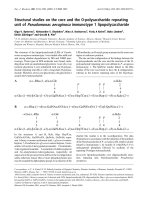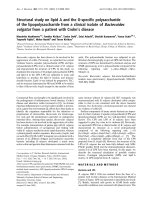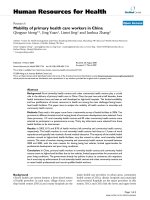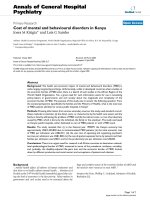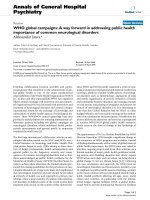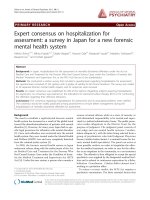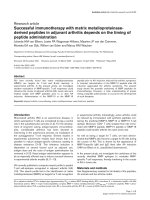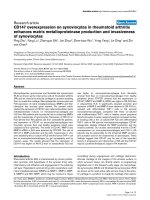Báo cáo y học: "Contextual influences on health worker motivation in district hospitals in Kenya" pdf
Bạn đang xem bản rút gọn của tài liệu. Xem và tải ngay bản đầy đủ của tài liệu tại đây (617.04 KB, 10 trang )
BioMed Central
Page 1 of 10
(page number not for citation purposes)
Implementation Science
Open Access
Research article
Contextual influences on health worker motivation in district
hospitals in Kenya
Patrick Mbindyo*
†1
, Lucy Gilson
†2,3
, Duane Blaauw
†4
and Mike English
†1,5
Address:
1
Kenya Medical Research Institute Centre for Geographic Medical Research Coast-Wellcome Trust Collaborative Programme, P. O. Box
43640-00100 GPO, Nairobi, Kenya,
2
School of Public Health and Family Medicine, University of Cape Town, Observatory, 7925, South Africa,
3
Health Policy Unit, London School of Hygiene and Tropical Medicine, Keppel Street, London WC1E 7HT, UK,
4
Centre for Health Policy (CHP),
School of Public Health, Faculty of Health Sciences, University of the Witwatersrand, P.O. Box 1038, Johannesburg, 2000, South Africa and
5
Department of Paediatrics, University of Oxford, John Radcliffe Hospital, Oxford. UK
Email: Patrick Mbindyo* - ; Lucy Gilson - ;
Duane Blaauw - ; Mike English -
* Corresponding author †Equal contributors
Abstract
Background: Organizational factors are considered to be an important influence on health
workers' uptake of interventions that improve their practices. These are additionally influenced by
factors operating at individual and broader health system levels. We sought to explore contextual
influences on worker motivation, a factor that may modify the effect of an intervention aimed at
changing clinical practices in Kenyan hospitals.
Methods: Franco LM, et al's (Health sector reform and public sector health worker motivation: a
conceptual framework. Soc Sci Med. 2002, 54: 1255–66) model of motivational influences was used
to frame the study Qualitative methods including individual in-depth interviews, small-group
interviews and focus group discussions were used to gather data from 185 health workers during
one-week visits to each of eight district hospitals. Data were collected prior to a planned
intervention aiming to implement new practice guidelines and improve quality of care. Additionally,
on-site observations of routine health worker behaviour in the study sites were used to inform
analyses.
Results: Study settings are likely to have important influences on worker motivation. Effective
management at hospital level may create an enabling working environment modifying the impact of
resource shortfalls. Supportive leadership may foster good working relationships between cadres,
improve motivation through provision of local incentives and appropriately handle workers'
expectations in terms of promotions, performance appraisal processes, and good communication.
Such organisational attributes may counteract de-motivating factors at a national level, such as poor
schemes of service, and enhance personally motivating factors such as the desire to maintain
professional standards.
Conclusion: Motivation is likely to influence powerfully any attempts to change or improve health
worker and hospital practices. Some factors influencing motivation may themselves be influenced
by the processes chosen to implement change.
Published: 23 July 2009
Implementation Science 2009, 4:43 doi:10.1186/1748-5908-4-43
Received: 16 January 2009
Accepted: 23 July 2009
This article is available from: />© 2009 Mbindyo et al; licensee BioMed Central Ltd.
This is an Open Access article distributed under the terms of the Creative Commons Attribution License ( />),
which permits unrestricted use, distribution, and reproduction in any medium, provided the original work is properly cited.
Implementation Science 2009, 4:43 />Page 2 of 10
(page number not for citation purposes)
Background
A number of factors ranging from the individual to
national level operate together to influence how health
workers take up interventions to improve their work prac-
tices [1-5]. Often this influence works through the local
personal, educational, professional, community, or insti-
tutional environment in which work takes place, or the
social, cultural, economic, and political environments
more generally [1,2]. Specific efforts within these environ-
ments to manage health worker actions include a broad
set of incentives and sanctions [1]. At the individual
health worker level, many of these influences are under-
stood to affect a worker's motivation to act in desired
ways. Thus, understanding those factors that influence
worker motivation is important when trying to explain
why interventions that rely on changing worker behaviour
succeed or fail.
However, worker motivation and its influence on chang-
ing clinical practices of health workers in low-income set-
tings [2,6,7] is rarely explored as a major factor that may
mediate or modify the effects of interventions [2,7-9].
More usually, studies of health worker's motivation
explore determinants of motivation by examining the
subjective perceptions of health workers [8,10-15] either
to understand effects of health sector reforms on worker
performance [10,11,14], or influences of performance
management on worker motivation [8,11,13].
We are conducting a study of an intervention aiming to
improve the quality of care for children in Kenyan govern-
ment hospitals. The study design and intended interven-
tions have been described elsewhere [16,17]. Conscious
of the fact that the characteristics of the hospitals as organ-
isations, their health workers and their interaction with
the research team might be major factors affecting imple-
mentation the research design also aimed to explore these
issues [7]. One topic of focus was, therefore, hospital staff
motivation. We reasoned that exploration of motivation
even if only at baseline would provide us with an
improved understanding of factors that might affect the
intervention's eventual success.
We have described elsewhere our efforts to develop a
quantitative measure of motivation to inform analyses of
the outcomes of the intervention project [18]. Here we
describe, based on an exploration of motivation, the
results of qualitative investigations in the study hospitals
that help describe the health system context within which
the intervention was delivered. In accompanying work,
we also describe the hospitals as contexts from a more tra-
ditional quality of care perspective [19], the process of
intervention [20] and reported barriers to use of clinical
practice guidelines [21]. These detailed descriptions will,
we hope, provide a thick description of the hospitals we
studied as 'typical' contexts providing health care services
in rural areas of Kenya. In so doing, we aim to improve
understanding of the broad range of issues affecting
attempts to change hospital practices and help others crit-
ically evaluate the generalisability of our future reports on
the effectiveness of the intervention.
Methods
Theoretical approach
The use of qualitative methodology was to explore the depth,
richness, and complexity of staff motivation in district hospi-
tals prior to the practice change intervention being imple-
mented [22-24]. We have adapted Kanfer's [25] model that
outlines the complex play of forces that influence motivation
that operate at individual, organisational, and societal levels
[9,25]. It divides determinants of motivation into 'will do'
(i.e., adoption of organisational goals) and 'can do' compo-
nents (i.e., mobilisation of personal resources to achieve
joint goals) [25]. The adaptation of Kanfer's [25] model was
informed by Franco et al.'s[7,9] work that extended the
model to provide a clearer understanding of the various fac-
tors that affect workers motivation before designing inter-
ventions that explicitly or implicitly affect motivation (see
Figure 1).
Tool development
Based on these theoretical considerations, Key Informant
Interview (KII) and Focus Group Discussion (FGD) tools
were developed. The KII tools, in particular, were devel-
oped with regard to the cadre of likely respondents, (jun-
ior cadres, middle, and senior level management). Each
guide had five sections comprising questions and probes
with flexibility to explore issues affecting particular cadres,
such as doctors or nurses. The qualitative guides were
piloted in two, non-study public hospitals in Kenya to test
for clarity of questions, health workers' comprehension of
the tools, and to gain preliminary insight into respond-
ents' perceptions of motivation. All tools were revised and
finalised after this piloting.
Sampling and data collection
The selection of study hospitals has been described in full
elsewhere. Briefly, they comprised eight rural district hos-
pitals from four of Kenya's provinces [16] selected to rep-
resent a range of institutional, geographic, socio-
economic, and epidemiological settings. The nature and
scope of the study was discussed with study hospitals
prior to any data collection. Once they had agreed to take
part, the first major contact with the research team was the
conduct of two-week baseline surveys run in parallel
across the country. These surveys focused on a broad qual-
ity of care assessment described fully in an accompanying
manuscript [19]. The qualitative data described here were
collected by the lead author during one-week visits to each
hospital made after the departure of the baseline survey
teams and before the results of baseline surveys were pro-
vided to the hospitals. These visits were conducted during
Implementation Science 2009, 4:43 />Page 3 of 10
(page number not for citation purposes)
August and September 2006 prior to any intervention. A
convenience sampling approach was used to select partic-
ipants to be interviewed in English (the language of all
primary, secondary, and tertiary education in Kenya).
Because the numbers of some key informants (hospital
chief executive officer (CEO), administrator, matron, and
ward in-charges) and clinicians (doctors and clinical offic-
ers, or COs) were few, an effort was made to interview all
present during the one-week visit.
In this study, the main focus of data collection was profes-
sional staff working in areas with regular contact with sick
children in their day-to-day work because the intervention
was aimed at improving paediatric care. FGDs were con-
ducted among nurses (especially in maternity and child
health sections) because they form over 50% of the clini-
cal staff in the hospitals. FGDs were mainly done in the
late afternoons because workloads reduced considerably
in this period. Throughout the one-week visits to hospi-
tals the principal investigator (PI) was an engaged
observer of health worker roles, attitudes, and practices,
and the functioning of the hospital as an institution, keep-
ing detailed field notes to supplement interview data.
Data analysis
In response to some sensitivity about tape-recording,
detailed notes of interviews and group discussions were
the primary data record with tape recordings used to sup-
plement these where possible (in fewer than 20% of inter-
views). All notes of interviews undertaken in the field
were transcribed into MSWord 2003 (Microsoft Corpora-
tion, USA) by the PI. These were then imported into
NVIVO7 software (QSR International Pty Ltd, Australia)
categorised by type of interview (FGD, small group, key
informant, or observations). Each transcript had a unique
identifier comprising of date, hospital code, type of inter-
view, and participant type, allowing exploration of data
by subgroup (e.g., health worker cadre).
Coding into themes was carried out in a three-fold man-
ner. The initial coding process followed the directed con-
tent analysis procedure [26] where theory was used to
guide the coding process. This was done during fieldwork
where the investigator examined his notes at the end of
every day and identified any issues that needed further
exploration or clarification. This was achieved by return-
ing to the same individual or exploring arising issues with
new participants. The second was during transcription
where, independent of the first phase, prominent issues
were marked for further exploration. Finally, after import-
ing the transcripts to NVIVO7, conventional coding
(where coding categories are directly derived from the text
data [26]) was performed without reference to the results
of the first two coding processes. Results from the three
processes combined with views of a second, independent
reading by a second investigator (ME) of more than half
of the transcripts, and insights from on-site observations
were reviewed and used to derive relevant major thematic
Influences on worker motivationFigure 1
Influences on worker motivation.
Implementation Science 2009, 4:43 />Page 4 of 10
(page number not for citation purposes)
categories. Codes that initially seemed to be different were
re-examined and found to provide additional explanation
for the larger categories, a process that improved our
explanatory ability.
Ethical issues
Ethical clearance for these studies was obtained from
Kenya's National Ethics Review Committee, and permis-
sion was gained from the heads of each hospital before
work started. Written consent was sought for interviews
and FGDs from the study participants.
Results
A total of 185 staff comprising of hospital directors,
matrons and administrators (n = 19); nurses (n = 92),
doctors (n = 13), pharmacists (n = 4) and COs (n = 36);
and other paramedics comprising of laboratory, dental,
orthopaedic, and pharmaceutical technologists (n for
group = 21) contributed data (Table 1). Overall, the
majority of respondents were female, which concurs with
the findings of the 2004 MoH Human Resource Mapping
exercise that found more female workers (52.7%) than
male (47.3%) in Kenya's health workforce [27]. In Kenya,
COs are a form of substitute physician undergoing a four-
year academic and internship training. They are twice as
numerous as doctors in the health system, being major
providers of clinical services in rural hospitals. Their pay is
comparable to that of nurses and usually less than 50% of
that of even junior physicians.
All FGDs (n = 5, with 39 participants) were carried out in
the maternity and child health sections. In other areas,
low staff numbers only made it possible to conduct indi-
vidual (n = 90) or small group interviews (n = 20, with 56
participants). All respondents found the study and its top-
ics to be very timely. Even so, a few respondents (about
5%) found questions relating to promotions, salary, and
training to be very sensitive and seemed guarded when
addressing these issues.
In line with our conceptual framework and our intention
to provide a rich, contextual description of the hospitals
studied, we present our data stratified by the level at
which factors may operate to influence motivation
(national, institutional, and personal). We then present a
description of their effects in discussing motivational out-
comes. While recognising that this represents a simplifica-
tion of the interrelatedness of many factors and their
consequences, we hope this aids readers' appreciation of
the intervention's context and their understanding of how
an intervention delivered at the hospital level may or may
not influence health worker behaviour.
Personal level
Altruism, prestige and professionalism
Various reasons account for why health workers chose to
become health care workers. Older respondents professed
to have been attracted to join healthcare by the altruistic
nature of the service (rewards associated with caring for
others) with some nurses liking nursing: 'I like nursing
because it is a helping profession, just like being a Pastor
in a church' [FGD MCH Nurses, H5]. Other health work-
ers joined due to the prestige associated with medical
work. The attraction of hospital work might also have
been additionally influenced by working with skilled col-
leagues, especially if working with them resulted in appre-
ciation by patients and/or their relatives.
'Sometimes when the patients become well, they return
and give you a chicken kama shukrani kwa kazi mzuri uli-
yofanya' (as thanks for the good work you did). [FGD
MCH Nurses, H5]
Whatever the reason for joining, a strong sense of profes-
sional attachment subsequently reinforced by training or
Table 1: Numbers of interviews by hospital
Hospital Code Key Informant Interviews Focus Group Discussions* Small Group Interviews#
H1 14 0 4 (3,2,3,2)
H2 15 1 (7) 3 (4,2,3)
H3 14 1 (5) 2 (2,2)
H4 6 1 (7) 2 (2,2)
H5 9 1 (10) 0
H6 7 0 4 (3,4,3,4)
H7 13 1 (10) 3 (2,3,4)
H8 12 0 2 (3,3)
Total 90 5 (39) 20 (56)
*To be classified as a focus group discussion, an interview had to have at least five members of staff excluding the interviewer. The brackets show
the number of staff present in that particular session.
#Small group interviews comprised of discussions that had two to four staff members. The brackets show the number of staff present in the
sessions held.
Implementation Science 2009, 4:43 />Page 5 of 10
(page number not for citation purposes)
organizational/professional ethos was commonly
reported among all age groups.
Job security
In addition to these, young respondents also stated that
they were influenced by the job security offered by health
care work (discussed hereafter). It was thought that 'the
only problem with working for MSF (Medecin Sans Fron-
tieres, a non-governmental organization) is that one can
be sacked any time. With the government, it takes time.
They have to find out what went wrong' [Nurse, H3].
Despite appreciating the advantages that government
employment provides, some workers took advantage of
this situation. As one hospital CEO stated, 'there are peo-
ple who can't change because they are benefiting from the
system. You see that? And there is that element, civil serv-
ice – nothing can be done to me I will get my salary'
[Medical Superitendent, H3].
Unmet expectations
Perceptions varied between older and younger respond-
ents, the former resigning themselves to working for a
future that had increasingly become gloomy. This was
attributed to unfulfilled expectations because the condi-
tions of service had deteriorated from the late 1980s
through the 1990s when many of them were recruited.
'We just work because we need to, but we are not happy.
Even if we retire, utaninginia kwa kaburi kabla ya kupata
marupurupu yako (you will teeter by the grave before you
get your benefits).' [Small Group Interview of Nurses, H6]
The younger workers in comparison were happy just to
have a job, but did not trust the system to look after them
in the long term. For example, a few of the young workers
accepted the fact that 'salary is a significant de-motivator
but I have no problem with it at the moment as I am look-
ing for experience and move on' [CO, H1].
Challenged by the demands of clients
Workers sense of fulfilment was challenged by inability to
meet the obvious need and high expectations of clients. A
medical doctor explained why he found working in his
local area difficult:
'You know when you come from the local area na watu
wako wajue unado job hapa, masocial zinakuwa mob
[and your people know that you are working here, you get
many patients (referring to patients coming from his vil-
lage)]. They come, mafriends, maneighbours na marela
(friends, neighbours, and relatives) to get assistance from
me they report to me kabla ya kuingia hosi (before reg-
istering as patients in the hospital).' [Medical Doctor, H2].
Organizational (hospital) level
Physical constraints
Reported constraints affecting health workers' ability to
serve patients include shortages of staff, drugs, and non-
medical supplies, often in combination with old build-
ings that resulted in 'staff just work [ing] to clear the queue
but not to provide quality work. They do not see the prob-
lem of the person' [CO, H7].
System performance is affected in a knock-on sense if
there are considerable numbers of workers having multi-
ple roles that they have little time to perform well. This is
the case where senior officers working in the hospitals get
extra duties at the district headquarters and are not avail-
able to carry out their hospital based functions, stretching
the abilities of those who work underneath them:
'The pharmacist who runs the hospital is also responsible
for the district which has many training functions. This
leaves me alone to run the hospital pharmacy.' [Pharma-
ceutical Technologist, H5].
This has system-wide implications for recent governmen-
tal management interventions aimed at improving hospi-
tal and worker performance, such as the introduction of
the Rapid Results Initiative (RRI). The RRI seeks to intro-
duce systemic changes in the health system. Hospitals
develop targets on issues of national importance and
agree to meet these in one-hundred days. However, short-
ages of staff with those remaining having multiple roles
has led to questions about such initiatives:
'RRI has been badly affected by the shortage of staff, espe-
cially in the running of ARVS due to the high HIV/AIDs
rates in the district. Do you know that they [hospital man-
agement] have been refusing staff to go on leave in order
to meet the targets? The question is that RRI will remain
and staff will have to go on leave – so what will happen?'
[CO, H7].
Relationships between colleagues
Constraints at the workplace could also be attributed to
problems with local supervisors who do not appreciate
some health workers but instead look for mistakes leading
to tension between workers:
'They are not supporting the nurses at all. The doctor
comes, he will do the reviews, off. But the nurse is left with
that patient. Come to night duty we have almost 60
patients in post-natal with one nurse plus how many beds
– eight eight 16 beds 18 beds ' [Nurse, H6].
Both nurses and doctors reported the CO cadre to have
relatively poor inter-professional relations with them,
Implementation Science 2009, 4:43 />Page 6 of 10
(page number not for citation purposes)
with particular concerns expressed over their perform-
ance. However, one senior CO felt differently about the
situation, stating that 'My COs feel sandwiched between
doctors and nurses. They feel like endangered species as if
anything bad happens, it is blamed on them. If everything
is okay, they do not seem to appear' [District CO, H3].
Lack of fairness
Lack of fairness in ensuring equal access to opportunities,
such as training seminars, can be de-motivating:
'At times, in-charges [ward supervisors] get people from
their own tribe. There is a lot of ethnicity in the hospital
among the supervisory level but not in the lower cadres.
The administration also functions along ethnic lines and
is not good.' [Nurse, H7].
The perception of fairness must also extend to dealing
firmly with indiscipline:
'COs really protect one another – so bad officers go
unpunished. If a nurse reports that there is no CO and
calls a doctor to see patients, the nurse will be harassed –
she is caught in between the two.' [Acting Hospital
Matron, H7].
Lack of incentives
Even though many issues that cause low motivation can-
not be resolved at hospital level, our work reveals that
hospital management can work to mitigate low staff moti-
vation. There were some examples of how some simple,
local, non-financial incentives might help, such as offer-
ing lunch to staff working in critical areas or providing a
separate room where hospital staff (and their families)
can come for treatment when sick. One doctor felt that:
'They can at least offer tea . look, we chase patients to pay
fees. For example, take the issue of filling NHIF forms
[National Health Insurance Fund]. This is an extra load on
us, it is a clerical job. The hospital can earn as much as 200
K (KES 200,000) per month from the forms alone but
none of this is ever used to reward or provide incentives to
us. So, if they do not give us some of it, it gets lost. You
know, the forms pile up and if not claimed within three
months, the money is lost.' [Doctor, H2].
On the other hand, careful thought must be paid when
considering either changing ways of doing things or with-
drawing instituted perks on worker motivation. For exam-
ple, 'the hospital was providing 10:00 a.m. tea. With the
beginning of the new year (2006), the new med sup [med-
ical superintendent] said that there was no money for this
facility and it was stopped. People work to generate
money but it is not clear what uses the money is put to
when generated.' [Nurse, H7].
Recognition and appreciation
Recognising and appreciating workers' efforts to do a
good job were apparently important influences improv-
ing motivation and may have trivial financial implica-
tions. However, respondents in some settings argued that
although the hospital management was in a position of
influence and could improve their motivation to work,
they did not take up this role:
'A little effort by the med sup to have, say, an annual proc-
ess of recognising staff say, Nurse, CO, Doctor, etc would
really help staff to realise that the management was watch-
ing what they do and would reward good work.' [Senior
CO, H1]
That managers did not bother with this aspect of staff
management has made many health workers feel unap-
preciated:
'Like I remember when I was in Siaya, the Medical Super-
intendent there started this initiative when he was there,
so he picked CO of the year, nurse of the year, laboratory
staff of the year. The CO was given a wall clock, nurse was
given a set of cups, I think it was encouraging – somebody
is seeing what you are doing. So somebody, another per-
son will also say if so and so got, why can't I struggle?'
[Senior Orthopaedic CO, H1].
Communication
A considerable part of good management is good commu-
nication between hospital management and its staff.
However, most respondents felt there was little communi-
cation, and if it took place it was often performed poorly:
'They are the right people, they just need to improve at
least communication. Communication is very good to an
adult, when you are told wait, you are able to wait this
one is not possible but if we tried this one, we can try it.
Yes, at least there is some communication. But if some-
body keeps quiet then you don't know if you are doing the
right thing or you are not doing the right thing.' [Nurse,
H6]
Commitment of managers to improve staff conditions
Despite the preceding, health worker motivation seemed
improved in the sites where the hospital director person-
ally took charge and created favourable working condi-
tions to which staff responded positively:
'So then I became a bit committed to my work because
people were willing, systems were moving, high bosses
have been very supportive, the NGOs [non-governmental
organizations] have been coming and they are very sup-
portive and I have found things moving.' [Medical Super-
intendent, H3].
Implementation Science 2009, 4:43 />Page 7 of 10
(page number not for citation purposes)
However, in some settings where the hospital director
could have been willing to try and improve work condi-
tions thus staff motivation, the staff were so poorly moti-
vated that they were no longer willing to reciprocate with
improved performance. For example:
'The med sup has done much work to improve the hospi-
tal. You know, the people here are very difficult. You can-
not be soft with them. That is why the med sup is a tough
person – that is the only way you can get things done over
here.' [CO Intern, H4].
National context
Schemes of service
Salary levels and promotion procedures are outlined in a
health worker's scheme of service. In all interviews and
across all cadres, both salaries and the way promotions are
handled were mentioned to be significant de-motivators.
In particular, the lack of promotions was mentioned as a
major issue because it affects upward progression and
therefore salaries:
'This business of staying for too long in one job group it
really de-motivates not just COs in fact all health workers
it's really de-motivating. It's really, really de-motivating
because it's as if you are working, nobody is seeing and
nobody is appreciating so you have time and time until
you say let me try a greener pasture somewhere.' [Senior
Orthopaedic CO, H1].
Even where promotion was possible, there was a clear
breakdown of trust between workers and the central
bureaucracy:
'Promotion is said to be automatic but this is only on
paper. In practice, one has to bribe.' [Hospital Pharmacist,
H3]
To some workers, a cadre's scheme of service was a reflec-
tion of the way they were recognized and appreciated. For
example, the existence of different outcomes from doing
similar work with similar levels of risk exposure results in
feelings of unfairness:
'There is no risk, uniform, travelling or extraneous allow-
ances yet we work every day and are taxed. For example, a
CO's travel allowance is 3 K [KES 3,000] yet doctors get 50
K [KES 50,000] and they come from the same place.' [Dis-
trict CO, H5].
Another example is the provision of the non-practice
allowance meant to attract medical officers back into
Kenya's public sector that increases their salaries with the
proviso that they do not practice privately. The sense of
injustice felt by other cadres is compounded by the fact
that doctors continue with private practice even though
they continue getting the non-practice allowance:
'COs are not considered like doctors we are not allowed
to practise and are not given a non-practising allowance
like doctors. We serve the same government, so we should
be given the allowance.' [District CO, H3].
Low salaries were reported to de-motivate staff not just
because of unfavourable comparisons with other workers,
but because they threatened staffs' ability to meet their
daily needs and have a standard of living befitting of their
professional status in the community. This further
affected their retirement benefits as pensions are pegged
on the salary at the point of retirement:
'The new government increased salaries but made the
ones of senior staff to be very high and did not touch the
salaries of the lower cadres. We have been trying to calm
the COs but I feel that they [COs] are not for what we are
advising them.' [District CO, H5].
Career development
Many COs felt that their cadre was much maligned con-
sidering the opportunities available to their colleagues
(i.e., nurses and doctors) to progress upwards. For exam-
ple, 'Nurses can start from certificate to PhD. Why not
COs?' [CO Intern, H8]. This has been attributed to a
poorly functioning scheme of service for COs that has not
been reviewed in many years. As such, a senior CO felt
that 'there are many hindrances even at the council level.
The nurses' scheme has been okayed while the CO one
was refused. The question is why are there so many hin-
drances? It really demoralizes them [COs].' [District CO,
H8].
Even where opportunities for self-advancement through
training are possible, increased costs of training represent
a major barrier. The increased costs are attributed to first,
the government reducing or stopping altogether subsi-
dized training for most officers, and second, increases in
fees as institutions seek to recoup the lost government
subsidies from students.
Implications of low motivation
The combination of poor salaries, lack of promotions,
and poor access to training opportunities amongst other
factors result in low motivation. Poor performance and
lack of concern about performance are likely results result-
ing from the feeling that 'there is nothing to make us feel
that we should work' [CO, H8]. In addition, performance
is also threatened by burnout resulting from a combina-
tion of factors ranging from hospital-related issues, such
as heavy workloads and lack of medical supplies to the
way staff relate to the community where the hospital is
located:
Implementation Science 2009, 4:43 />Page 8 of 10
(page number not for citation purposes)
'We see a lot of burnout among staff which has resulted in
poor attitudes to patients and work. This has been com-
pounded by poor working conditions and negative atti-
tude from the community.' [Hospital Matron, H5].
Typical reactions include deliberate absenteeism where
'staff just collude with the COs to get sick-offs and then
some of them go out to work in private clinics in town'
[Hospital Matron, H6]. Another response is lack of time-
liness, with some hospitals having introduced attendance
registers to ensure that officers came and left on time,
although it is difficult at the hospital level to determine
whether these have worked:
'They [hospital staff] have started clocking in as a result of
the laxity, though, even if they come in on time, it is not
known if they are working well or not.' [Hospital Matron,
H6].
Other adaptive responses resulting from low motivation
and poor remuneration included being 'casual in their
approach to work or demand [ing] bribes or sell [ing]
the drugs given to them by medical representatives' [Dis-
trict CO, H2].
Discussion
What are the main findings?
The reports in our work alluding to poor communication,
lack of transparency in decision making, an impenetrable
and unfair bureaucracy, poor infrastructure, and few
resources all resonate with much published work from
low-income settings [8,10,11,13]. However, at the hospi-
tal level where strong and supportive leadership was
present, worker motivation appeared to be higher than in
sites that lacked this. This was seen to be critical to
improving worker motivation in sites where workers faced
significant shortages in equipment, tools and supplies.
This reiterates the important role that hospital manage-
ment, especially the hospital CEO, has in mediating the
effect of de-motivating factors at institutional or national
levels. For example, it is posited that the hospital CEO has
some leeway to provide local incentives that can improve
worker motivation which need not have major financial
implications. Examples include identifying and rewarding
well-performing health workers. This sends the message
that the hospital management is interested in and rewards
good performance.
Additionally, good working relationships between cadres
also enhance worker motivation. This can be facilitated by
the hospital management, for example by holding weekly
morbidity and mortality meetings attended by represent-
atives from all cadres where issues affecting health work-
ers' performance can be discussed fairly and decisions
made that are followed up. Where inter-cadre relations
have been found to be poor, low staff retention, job satis-
faction, and inefficiency of health care delivery have been
experienced [28], as is the case in Nigeria [29].
However well the hospital management works to create a
supportive working environment in the hospital, it is clear
that there are issues at system level that affect the motiva-
tion, and therefore performance, of health workers. We
found examples of Kerr's [30] argument that many sys-
tems reward behaviours that they are trying to discourage,
a finding similar to those reported from countries such as
Mali [8], Ethiopia [11], and Uganda [10]. For example,
recognition of worker's efforts has little cost implications
yet is not done [8,10,13,31], while staff who shirk their
duties or are rude to patients seem to be rewarded by the
long period of time it takes to sanction them [14]. On the
other hand, if the health system appears to 'favour' a cer-
tain cadre through provision of incentives in order to
retain them, it is likely that feelings of injustice by other
cadres will emerge leading to de-motivation. This in the
Kenyan system is apparent between doctors (who have
numerous allowances and clear career prospects) and COs
who, as substitute physicians, have significantly lower lev-
els of pay and benefits.
It is thought that a major factor creating conditions likely
to reduce motivation is the actual implementation of the
schemes of service in place [32]. Properly functioning
national schemes of service could greatly enhance worker
motivation, because every health worker would be treated
and remunerated fairly for what they do. In keeping with
literature from other countries, inadequate salary and
problems with promotion were mentioned by all inter-
viewed health workers as being very de-motivating, being
particularly related to retirement benefits
[10,11,13,14,31]. In Kenya's health sector, this is perhaps
exacerbated by feelings of unfairness. Within the health
sector, and as described above, doctors have been receiv-
ing a number of allowances aimed at improving their
recruitment and retention rates, while COs and other par-
amedics have not received such financial incentives. In
addition, comparisons with other non-health government
employees, such as those in the uniformed forces or teach-
ers who also offer essential services but have had their sal-
aries increased, are unfavourable perhaps further
contributing to feelings of injustice. While the hospital
management cannot directly rectify issues related to
delayed promotions or poor salaries, the hospital man-
agement can at least act as advocates for their staff. Such
actions rely on having good communication channels,
often absent, that ensure all are clear on what is possible
to help manage health workers expectations of local man-
agement.
In theory, there exists in the hospitals studied an annual
performance appraisal process, but this appears not to be
Implementation Science 2009, 4:43 />Page 9 of 10
(page number not for citation purposes)
linked to worker rewards or sanctions. Dieleman and her
colleagues [8] found in Mali that appropriate perform-
ance management (i.e., job descriptions, supervisions,
continuous education, and performance appraisal) can
positively influence the main motivators of health work-
ers (i.e., responsibility, training and recognition, and sal-
ary). It is thus vital that initiatives such as the recently
introduced public sector performance improvement initi-
ative, of which the rapid results initiative is a part, are not
just a paper exercise.
In the setting described, reinforcing a health worker's rea-
sons for becoming a health care worker and attachment to
their profession by providing a working environment that
supports their work would seem powerfully motivating. In
this light, difficulties in the health system that affect the
ability to work well undermine a health worker's self-worth
and commitment [28], a finding similar to that observed by
Kyaddondo and Whyte in Uganda [10]. In our study, sites
that were able to support workers' professional identity
coupled with continuing professional education (CPE)
were found to provide a generally more motivating envi-
ronment than those without these features.
Which factors can the planned intervention address and
how?
Woodward [1] argues that a hospital must provide an
environment where attempts to introduce change will be
positively rewarded and that removing cues that make
health workers revert to their old behaviour will continue
to support change [1,22,23]. Thus, features of sites with
environments that could help accept change might
include supportive leadership ensuring workers have
good access to tools and medical supplies. Other features
include a hospital management that creates opportunities
for its health workers to access training, use of simple local
incentives to positively influence worker motivation and
collaboration with civil society, and donors to improve
hospital facilities. Few of these characteristics were appar-
ent in the sites we studied.
Instead, a range of problems in all sites were reported,
such as sometimes poor teamwork across cadres, signifi-
cant shortages of resources, inadequate infrastructure and
mistrust in the decision-making process particularly with
regard to training. These difficulties at the hospital level
were compounded by major, national level issues, such as
inadequate schemes of service, mistrust, and low salaries.
Although the number of hospitals (eight) included in the
study is relatively small, we believe that our description of
these sites is likely to be representative of a large section of
the rural government hospital sector in Kenya.
Strengthening health workers professionalism
In all eight sites visited, health workers expressed the need
to upgrade their skills but lacked the funds to undertake
courses that addressed this. The multifaceted intervention
being introduced in these sites aims at implementing evi-
dence-based clinical practice guidelines (CPGs) and
improving the quality of care being conducted in Kenyan
hospitals [16]. The guidelines summarise the available
evidence on major diseases and indicate that good care
can be provided after relatively brief training with only
basic resources [17]. To support the implementation of
guidelines, local facilitators from within the hospital are
to be provided to encourage the provision of good care,
liaise with administrators, and help solve problems
related to supplies and equipment [19,20]. The interven-
tion could therefore improve worker's motivation and,
when linked to positive feedback, could further encourage
good performance [16,17,20]. In this regard, setting clear
standards of what is expected, fostering teamwork, and
being able to recognise progress towards these standards
may be helpful.
Reinforcing supportive leadership at hospital level
Another major aspect of the intervention aims to improve
hospital and health worker motivation and performance
through supportive supervision from credible peers
linked to feedback on performance and possibly bench-
marking with other hospitals [20]. By monitoring how
well the hospital has performed in certain preselected and
modifiable criteria, shortcomings can be identified and
actions taken to improve performance in the hope of
introducing a virtuous cycle of improvement [20]. Such
effects will depend on the relationships between imple-
menters and hospitals' management, and would benefit
from development of the hospital's leadership towards
providing as good a working environment as feasible. Ide-
ally, these institutional initiatives would be combined
with changes in the national health system context that
should include increasing the health workforce and
improving resource availability, better remuneration, reli-
able and transparent implementation of rules, and greater
recognition of good service.
Conclusion
It is clear factors influencing health worker motivation are
interlinked, complex, and operate at different levels.
While most of those at a national level currently nega-
tively influence health worker motivation in Kenyan dis-
trict hospitals, it is noteworthy that some improvement in
motivation can be attributed to how well a hospital's
management organizes and runs the hospital. Workers'
financial considerations cannot be gainsaid; however,
implementing simple non-financial measures to improve
worker motivation may also have some effect. However,
interventions that aim to change worker practice simply
by offering training are likely to fare poorly unless atten-
tion is paid to those factors influencing the motivation of
health workers to change and perform well at individual,
organizational, and system levels.
Publish with BioMed Central and every
scientist can read your work free of charge
"BioMed Central will be the most significant development for
disseminating the results of biomedical research in our lifetime."
Sir Paul Nurse, Cancer Research UK
Your research papers will be:
available free of charge to the entire biomedical community
peer reviewed and published immediately upon acceptance
cited in PubMed and archived on PubMed Central
yours — you keep the copyright
Submit your manuscript here:
/>BioMedcentral
Implementation Science 2009, 4:43 />Page 10 of 10
(page number not for citation purposes)
Competing interests
The authors declare that they have no competing interests.
Authors' contributions
ME conceived the idea for this work and obtained funding
to support it. The working approach was developed by PM
with support from the other authors. All fieldwork was
conducted by PM who was primarily responsible for the
analyses and drafting the manuscript with contributions
from all authors. All authors contributed to and approved
the final manuscript.
Acknowledgements
This work is published with the permission of the Director, KEMRI. We
would like to thank the Division of Child Health (Ministry of Health) and
the staff of participating District Hospitals for their collaboration. This
work is funded through a Wellcome Trust Senior Research Fellowship
awarded to Dr. Mike English (#076827). The funders have played no role
in the design of this study or the decision to publish.
References
1. Woodward C: Strategies for assisting health workers to mod-
ify and improve skills: Developing quality health care – a
process of change. In Issues in Health service delivery Geneva: World
Health Organization; 2000.
2. Rowe AK, de Savigny D, Lanata CF, Victora CG: How can we
achieve and maintain high-quality performance of health
workers in low-resource settings? The Lancet 2005,
366:1026-1035.
3. Shaw B, Cheater F, Baker R, Gillies C, Hearnshaw H, Flottorp S, Rob-
ertson N: Tailored interventions to overcome identified bar-
riers to change: effects on professional practice and health
care outcomes. Cochrane Database of Systematic Reviews
2005:CD14005470.
4. Grimshaw J, Thomas R, MacLennan G, Fraser C, Ramsay C, Vale L,
Whitty P, Eccles M, Matowe L, Shirran L, et al.: Effectiveness and
efficiency of guideline dissemination and implementation
strategies. Health Technology Assessment 2004, 8:6.
5. Wallin L, Ewald U, Wikblad K, Scott-Findlay S, Arnetz BB: Under-
standing Work Contextual Factors: A Short-Cut to Evi-
dence-Based Practice? Worldviews on Evidence-Based Nursing 2006,
3:153-164.
6. Dolea C, Adams O: Motivation of health care workers: review
of theories and empirical evidence. Cahiers de Sociologie et
Démographie Médicale 2005, 45:135-161.
7. Franco L, Bennett S, Kanfer R, Stubblebine P: Determinants and
consequences of health worker motivation in hospitals in
Jordan and Georgia. Social Science & Medicine 2004, 58:343-355.
8. Dieleman M, Toonen J, Toure H, Martineau T: The match between
motivation and performance management of health sector
workers in Mali. Human Resources for Health 2006, 4:2.
9. Franco LM, Bennett S, Kanfer R: Health sector reform and public
sector health worker motivation: a conceptual framework.
Social Science & Medicine 2002, 54:1255-1266.
10. Kyaddondo D, Whyte SR: Working in a Decentralized System:
A Threat to Health Workers' Respect and Survival in
Uganda. International Journal of Health Planning and Management
2003, 18:329-342.
11. Lindelow M, Serneels P: The performance of health workers in
Ethiopia: Results from qualitative research.
Social Science &
Medicine 2006, 62:2225-2235.
12. Dieleman M, Cuong P, Anh L, Martineau T: Identifying factors for
job motivation of rural health workers in North Viet Nam.
Human Resources for Health 2003, 1:10.
13. Manongi R, Marchant T, Bygbjerg IC: Improving motivation
among primary health care workers in Tanzania: a health
worker perspective. Human Resources for Health 2006, 4:6.
14. Agyepong I: Reforming health service delivery at district level
in Ghana: the perspective of a district medical officer. Health
Policy Plan 1999, 14:59-69.
15. Manzi F, Kida T, Mbuyita S, Palmer N, Gilson L: Exploring the influ-
ence of workplace trust over health worker performance:
preliminary national overview report Tanzania. In Health Eco-
nomics and Financing Programme, London School of Hygiene and Tropical
Medicine Johannesburg: Centre for Health Policy; 2004.
16. English M, Irimu G, Wamae A, Were F, Wasunna A, Fegan G, Peshu N:
Health Systems Research in a Low Income Country – Easier
Said Than Done. Archives of Disease in Childhood 2008, 93:540-544.
17. Irimu G, Wamae A, Wasunna A, Were F, Ntoburi S, Opiyo N, Ayieko
P, Peshu N, English M: Developing and introducing evidence
based clinical practice guidelines for serious illness in Kenya.
Arch Dis Child 2008, 93:799-804.
18. Mbindyo PM, Blaauw D, Gilson L, English M: Developing a Tool to
Measure Health Worker Motivation in District Hospitals in
Kenya. Human Resources for Health 2009, 7:40.
19. English M, Ntoburi S, Wagai J, Mbindyo P, Opiyo N, Ayieko P, Opondo
C, Migiro S, Wamae A, Irimu G: An Intervention To Improve Pae-
diatric and Newborn Care in Kenyan District Hospitals: Under-
standing the Context. Implementation Science 2009, 4:42.
20. Nzinga J, Mbindyo P, Mbaabu L, Warira A, English M: Documenting
the Experiences of Health Workers Expected to Implement
Guidelines During an Intervention Study in Kenyan Hospi-
tals. Implementation Science 2009, 4:44.
21. Nzinga J, Ntoburi S, Wagai J, Mbindyo P, Mbaabu L, Migiro S, Wamae A,
Irimu G, M E: Implementation Experience During an Eighteen
Month Intervention to Improve Paediatric and Newborn Care
in Kenyan District Hospitals. Implementation Science 2009, 4:
45.
22. Webb B: Using Focus Groups as a Research Method: A Per-
sonal Experience. Journal of Nursing Management 2002, 10:27-35.
23. Britten N: Qualitative Research: Qualitative interviews in
medical research. British Medical Journal 1995, 311:251-253.
24. Farmer T, Robinson K, Elliott SJ, Eyles J: Developing and Imple-
menting a Triangulation Protocol for Qualitative Health
Research. Qualitative Health Research 2006, 16:377-394.
25. Kanfer R: Measuring Health Worker Motivation in Develop-
ing Countries. In Major Applied Research 5 Bethesda, MD: Partner-
ships for Health Reform Project, Abt Associates Inc; 1999.
26. Hsieh H-F, Shannon SE: Three Approaches to Qualitative Con-
tent Analysis. Qualitative Health Reasearch 2005, 15:1277-1288.
27. MOH: Human Resource Mapping and Verification Exercise.
Nairobi: Ministry of Health; 2005.
28. Gilson L, Palmer N, Schneider H: Trust and health worker per-
formance: exploring a conceptual framework using South
African evidence. Social Science & Medicine 2005, 61:1418-1429.
29. Ogbimi R, Adebamowo C: Questionnaire survey of working rela-
tionships between nurses and doctors in University Teaching
Hospitals in Southern Nigeria. BMC Nursing 2006, 5:2.
30. Kerr S: On the Folly of Rewarding A, While Hoping for B. The
Academy of Management Journal 1975, 18:769-783.
31. Mathauer I, Imhoff I: Health worker motivation in Africa: the
role of non-financial incentives and human resource manage-
ment tools. Human Resources for Health 2006, 4:24.
32. DPM: Pay Policy For The Public Service. Nairobi: Directorate
of Personnel Management; 2006.
